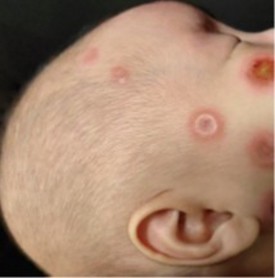Rare: the prevalence of congenital AV III block is 1/20,000 pregnancies. Passive immune pathology mainly caused by transplacental transfer of maternal autoantibodies directed against SSA/Ro and SSB/La, nuclear and cytoplasmic RNA located in all cells, or against the NRP protein. However, only 1 to 2% of pregnant women suffering from an autoimmune disease with autoantibodies directed against SSA/Ro or SSB/L give birth to a child with a neonatal lupus. On the other hand, in 50% of cases of neonatal lupus, the mother is asymptomatic but carries autoantibodies. The consequences are temporary except for the cardiac involvement that has a mortality rate of 20%.
Clinical presentation:
- a skin rash (25 %, especially in girls): onset around 2-3 months of age but may be present at birth and disappears within 6 to 12 weeks

source: NEJM 2025
- a liver damage (25 %): hepatomegaly, elevation of liver enzymes levels with spontaneous healing; sometimes neonatal hemochromatosis (see this term)
- a hematologic involvement: thrombocytopenia, sometimes pancytopenia
- a often paucisymptomatic neurological involvement that could later be associated with speech and learning disorders
- a heart involvement (20 %): cardiomyopathy, endocardial fibroelastosis, cardiac valves involvement.
- a type I, II or III AV block: in utero, a heart rate < 55 bpm leads to a fetal hydrops; the AV block may appear later in life.
Treatment: in case of severe involvement, gammaglobulins, corticosteroids
Anesthetic implications:
ECG and echocardiography; check the hepatic function; in emergency situation, a temporary percutaneous epicardial pacing through the subxyphoid, percutaneous (risk of false contact and burning, direct muscle stimulation), esophageal or intravenous (through a central venous access) routes can be performed. It is wise to use a continuous infusion of isoproterenol (0.1-0.2 µg/kg/min) and anesthethic agents which do not result in slowing of the heart rate (ketamine, isoflurane, sevoflurane, for example). The hemodynamic response to atropine is generally poor (less than 20% increase in heart rate). In case of type III AV block, test the proper functioning of the pacemaker
References :
- Castilla M, Jerez M, Llacer M, Martinez S.
Anaesthetic management in a neonate with congenital heart block.
Pediatr Anesth 2004, 14:172-5.
- Razka T, Rifai N, Delapintiere A, Magnenant E Vaksmann G, Bonnevalle M, Lequien P, Storme L.
Electro-stimulation in preterm neonates with congenital auriculo-ventricular block. Report of three cases.
Eur J Pediatr 2004; 163: 85-8
- Kiran U, Dutta A, Mehra A, Das SN, Zuber K.
Neonatal lupus erythematosus with complete congenital heart block and severe respiratory distress: anesthetic management for urgent pacemaker implantation.
Acta Anaesthesiol Scand 2006; 50:1315-6.
- Tunaoglu FS, Yildirim A, Vurali D.
Isolated congenital heart block.
Tex Heart Inst J 2010; 37: 579-83.
- Klein-Gitelman MS.
Neonatal lupus : what we have learned and current approaches.
Curr Rheumatol Rep 2016: 8: 60, DOI 10.1007/s11926-016-061-z - Sreevastava DK, Setlur R, Sharma VK, Padmini HS, Puri B, Bhargava AK.
Anesthetic management of an infant with lupus and congenital complete heart block.
Pediatr Anesth 2006; 16: 216-7. - Mao J, Ji C.
Neonatal Lupus.
N Engl J Med 392;13 : e35, doi:10.1056/NEJMicm2415348
Updated: April 2025